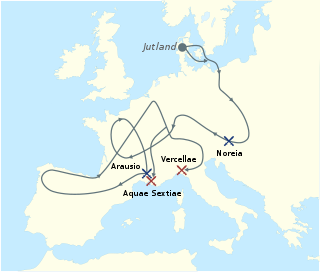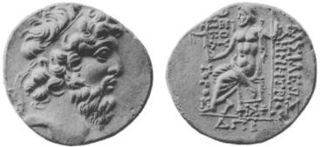Related Research Articles

The 2nd century BC started the first day of 200 BC and ended the last day of 101 BC. It is considered part of the Classical era, although depending on the region being studied, other terms may be more suitable. It is also considered to be the end of the Axial Age. In the context of the Eastern Mediterranean, it is the mid-point of the Hellenistic period.
This article concerns the period 149 BC – 140 BC.
This article concerns the period 169 BC – 160 BC.
Year 125 BC was a year of the pre-Julian Roman calendar. At the time it was known as the Year of the Consulship of Hypsaeus and Flaccus and the Fourth Year of Yuanshuo. The denomination 125 BC for this year has been used since the early medieval period, when the Anno Domini calendar era became the prevalent method in Europe for naming years.

Year 113 BC was a year of the pre-Julian Roman calendar. At the time it was known as the Year of the Consulship of Caprarius and Carbo and the Fourth Year of Yuanding. The denomination 113 BC for this year has been used since the early medieval period, when the Anno Domini calendar era became the prevalent method in Europe for naming years.
Year 164 BC was a year of the pre-Julian Roman calendar. At the time it was known as the Year of the Consulship of Torquatus and Longinus. The denomination 164 BC for this year has been used since the early medieval period, when the Anno Domini calendar era became the prevalent method in Europe for naming years.
Antiochus is a Greek male first name, which was a dynastic name for rulers of the Seleucid Empire and the kingdom of Commagene. In Jewish historical memory, connected with the Maccabean Revolt and the holiday of Hanukkah, "Antiochus" refers specifically to Antiochus IV Epiphanes.

Demetrius III Theos Philopator Soter Philometor Euergetes Callinicus was a Hellenistic Seleucid monarch who reigned as the King of Syria between 96 and 87 BC. He was a son of Antiochus VIII and, most likely, his Egyptian wife Tryphaena. Demetrius III's early life was spent in a period of civil war between his father and his uncle Antiochus IX, which ended with the assassination of Antiochus VIII in 96 BC. After the death of their father, Demetrius III took control of Damascus while his brother Seleucus VI prepared for war against Antiochus IX, who occupied the Syrian capital Antioch.

Cleopatra I or Cleopatra Thea, surnamed Eueteria was a ruler of the Hellenistic Seleucid Empire. She was queen consort of Syria from 150 to about 125 BC as the wife of three Syrian kings: Alexander Balas, Demetrius II Nicator, and Antiochus VII Sidetes. She ruled Syria from 125 BC after the death of Demetrius II Nicator, eventually in co-regency with her son Antiochus VIII Grypus until 121 or 120 BC.

Antiochus VIII Epiphanes/Callinicus/Philometor, nicknamed Grypus, was the ruler of the Hellenistic Seleucid Empire from 125 to 96 BC. He was the younger son of Demetrius II and Cleopatra Thea. He may have spent his early life in Athens and returned to Syria after the deaths of his father and brother Seleucus V. At first he was joint ruler with his mother. Fearing her influence, Antiochus VIII had Cleopatra Thea poisoned in 121 BC.

Antiochus IX Eusebes Cyzicenus was a ruler of the Hellenistic Seleucid kingdom. He was the son of Antiochus VII Sidetes and Cleopatra Thea. He left the kingdom in 129 BC and went to the city of Cyzicus, but he returned in 116 BC to challenge his half-brother Antiochus VIII for power.

Ptolemy XII Neos Dionysus was a king of the Ptolemaic Kingdom of Egypt who ruled from 80 to 58 BC and then again from 55 BC until his death in 51 BC. He was commonly known as Auletes, referring to his love of playing the flute in Dionysian festivals. A member of the Ptolemaic dynasty, he was a descendant of its founder Ptolemy I, a Macedonian Greek general and companion of Alexander the Great.

Ptolemy X Alexander I was the Ptolemaic king of Cyprus from 114 BC until 107 BC and of Egypt from 107 BC until his death in 88 BC. He ruled in co-regency with his mother Cleopatra III as Ptolemy Philometor Soter until 101 BC, and then with his niece and wife Berenice III as Ptolemy Philadelphus. He was a son of Ptolemy VIII and Cleopatra III, and younger brother of Ptolemy IX. His birth name was probably Alexander.
Cleopatra IV was Queen of Egypt briefly from 116 to 115 BC, jointly with her husband Ptolemy IX Lathyros. She later became queen consort of Syria as the wife of Antiochus IX Cyzicenus.

Cleopatra Selene was the Queen consort of Egypt from 115 to 102 BC, the Queen consort of Syria from 102–92 BC, and the monarch of Syria from 82 to 69 BC. The daughter of Ptolemy VIII Physcon and Cleopatra III of Egypt, Cleopatra Selene was favoured by her mother and became a pawn in Cleopatra III's political manoeuvres. In 115 BC, Cleopatra III forced her son Ptolemy IX to divorce his sister-wife Cleopatra IV, and chose Cleopatra Selene as the new queen consort of Egypt. Tension between the king and his mother grew and ended with his expulsion from Egypt, leaving Cleopatra Selene behind; she probably then married the new king, her other brother Ptolemy X.
This article concerns the period 99 BC – 90 BC.
Tryphaena was a Ptolemaic princess. She married the Seleucid king Antiochus VIII Grypus and was queen of Syria.

The Seleucid Dynastic Wars were a series of wars of succession that were fought between competing branches of the Seleucid royal household for control of the Seleucid Empire. Beginning as a by-product of several succession crises that arose from the reigns of Seleucus IV Philopator and his brother Antiochus IV Epiphanes in the 170s and 160s, the wars typified the final years of the empire and were an important cause of its decline as a major power in the Near East and Hellenistic world. The last war ended with the collapse of the kingdom and its annexation by the Roman Republic in 63 BC.
References
- ↑ Berney, Kathryn Ann; Ring, Trudy; Watson, Noelle (1996). International dictionary of historic places. Chicago (Ill.) London: Fitzroy Dearborn. p. 194. ISBN 978-1-884964-03-9.
- ↑ Houghton, Arthur (1989). "The Royal Seleucid Mint of Soli". The Numismatic Chronicle. 149: 15–32. ISSN 0078-2696.